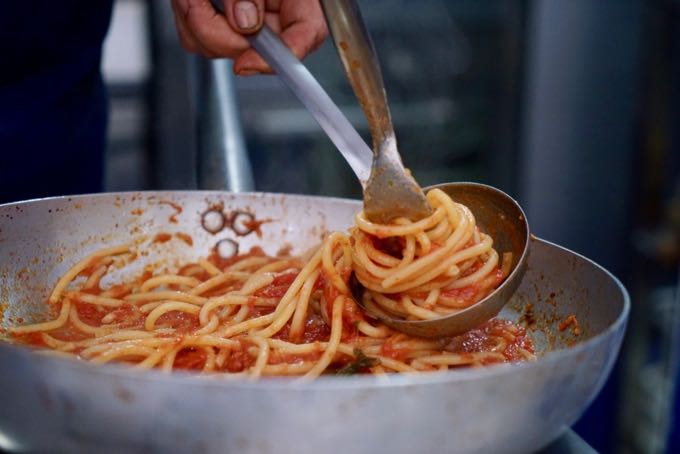
The one thing you’ve probably heard about pasta in Italy is that Marco Polo brought it here from China. This is almost certainly not true. Pasta has probably been going on in Italy for centuries, and may even date back as far as the Etruscans. But the pasta we are talking about, dried pasta, began its long road to our tables in the 18th century.
Dried pasta, unlike fresh pasta, is made from hard semolina, milled from durum wheat. Since this type of wheat grows in the south of Italy, in Sicily and in Campania, that is where much of the first pasta making industry developed. Particularly in the area in and around Naples, where the warm breezes off the hills assured that the pasta would dry, while the humid sea breezes insured it would not dry too fast, and crack. This reliance on natural setting meant that tourists to Naples commented on the streets filled with rows of pasta drying on the streets, terraces and even rooftops. Heaven, right?
But it was in nearby Gragnano that the first automation of pasta took hold. The small town was perfectly situated for drying pasta, with the dry Ponentino western winds coming off the hills, alternating with the warm and humid Vesuviano winds coming from the sea. And it was here that the extremely time consuming and strenuous process began to be automated. Dough made from durum wheat is extremely difficult to knead and it was here that the first automated kneading machines were made. It was also where the first presses that could extrude the unwieldy dough were put into action on a larger scale. And so it was from Gragnano that pasta began its way to becoming a more common food for masses, and not just a luxury for the upper class. Yet even though certain parts of the process were semi-automated, it was still being made a series of family run businesses that produced the pasta in small batches, in an artisanal manner.
And it was in Gragnano that some of the first drying rooms were invented. These rooms combined heat with wind, imitating the natural breezes so that pasta could be made all year round. The progress in Gragnano sought to preserve the traditional methods, especially maintaining the flavors that were the result of of the mountain breezes slowly drying local varieties of wheat over the course of several days.
As with all things, the process was adopted and industrialized and spread way beyond the pasta drying on the streets of Grangano. It was not long before big companies all over Italy began to produce pasta on a much larger scale, ramping up production by not only using inferior ingredients, but mostly by speeding up the drying process. While these advances has made Italian pasta one of the biggest exports around the world, it has also turned it into something that is a far cry from the traditionally made pasta still being made by some families in Gragnano and other parts of Italy.
While in Gragnano drying rooms were invented to mimic the natural breezes so that pasta could be made all year round,, big companies elsewhere in Italy left this far behind, speeding up the production process to make Italian pasta one of the biggest exports around the world.
Which is how we now arrive at the fact that not all dried pasta is created equal. And instead of talking about which is better, dried pasta or fresh pasta, I hope by now you realize that it’s more productive to be concerned telling the difference between great dried pasta and the more industrialized brands.
What’s the difference?
I recently got the chance to go behind the scenes, at two of the best pasta makers in Gragnano: Faella and Gentile (who are also two of my favorites). Both companies adhere to the older way of making pasta and their machinery produces relatively small quantities per batch. 1000 to 2000 kilos of semola di grano duro is turned into a bit more pasta.
There are several factors that differentiate artisanally dried pasta from the industrialized process. One, unsurprisingly is attention to ingredients (not only the flour, but also water) . Another is of course the process itself. Here are the major factors that differentiate artisanally made dried pasta from industrial brands:
Artisanally made pasta is extruded through bronze dies (vs. teflon) which gives it a rough texture that better absorbs the sauce.
Artisanally made pasta is dried at a lower temperature over a longer time which not only improves flavor but gives it a completely unique texture: firm and chewy, that is never found in industrially made pasta. In terms of timing we are talking about 20 minutes drying for industrially made pasta versus up to 48 hours drying time for artisanally made pasta.
Artisanally made pasta is made with just flour and water with no extra colorings, preservatives or additives. It is also usually made with high quality flour, as well as special attention to the water that is used
The importance of drying: This is probably the most important aspect of the process which differentiates the smaller, artisanal producers, from the industrial ones. Once the pasta is made, it is taken into drying rooms where over the course of up to 48 hours, wind and heat gently dry the pasta. This is not an automated process, since the timing and temperature can depend not only on the shape of the pasta, but the quality of the flour that day as well as the weather. It is up to the master Pastaio to decide exactly how to alternate air and heat, and it is he who decides when the pasta is ready to be packaged.
And if you have sometimes wondered why it is so difficult to cook pasta to that perfect al dente point, it is because the high heat used to dry industrial pasta practically pre-cooks the pasta, effecting the final texture.
Like many artisanally made food products in Italy, Pasta di Gragnano is recognized by an IGP label. The Consortium that monitors this process is the Consortium Gragnano Citta della Pasta. But like all such regulators, not everyone agreed with the rules. It’s not that the rules were too strict, but that they weren’t strict enough. Specifically regarding the drying process, the Consortium states that the pasta much be dried from 6 to 40 hours, at from 40 to 80 degrees Celsius. That is a huge amount of leeway and in fact allows for the making of quickly dried pasta at high temperatures. All this to say that even if a pasta is from Gragnano, it doesn’t necessarily mean it is the best.
Try this at home:
If you don’t quite believe me so far, in terms of the difference in taste and texture, then I have some homework for you. I’d like to you to try one of the high end brands, next to the one you usually buy at the supermarket. I realize this involves spending money. The high end pastas I’m talking about, by companies like Rustichella, Gentile, Faella , Martelli and Benedetto Cavalieri cost anywhere from 6 to 12 dollars for a pound, versus about $1.50 for a supermarket brand.. Because the difference in taste, in texture and in the finished dish is hard to describe here, you’re just going to have to experiment yourself. And if you have time, and energy, try making two batches of pasta, one of your regular brand, and one of the better ones. Then dress them with a simple coating of olive oil. Let me know what you think. I think that people have gotten so used to the idea of cheap pasta, that they don’t realize that there is alternative that tastes completely different. And better
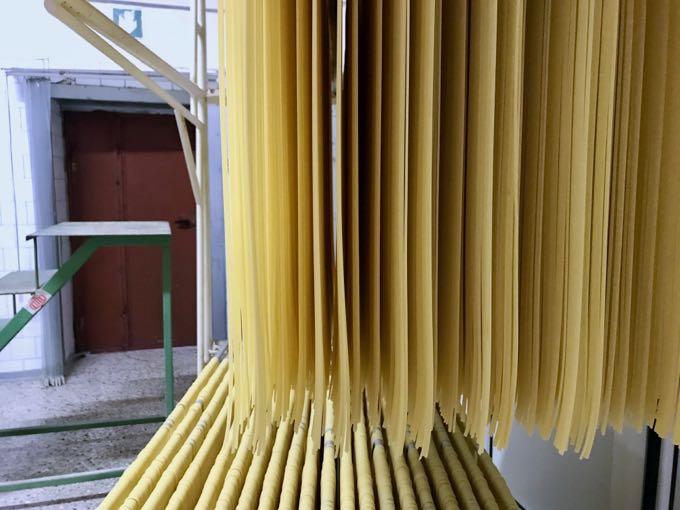
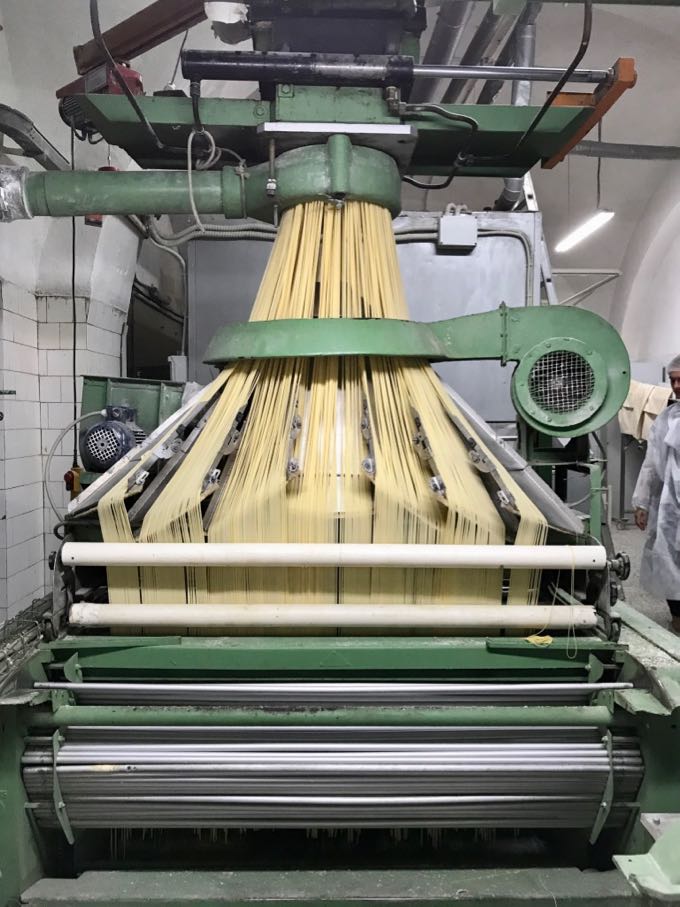
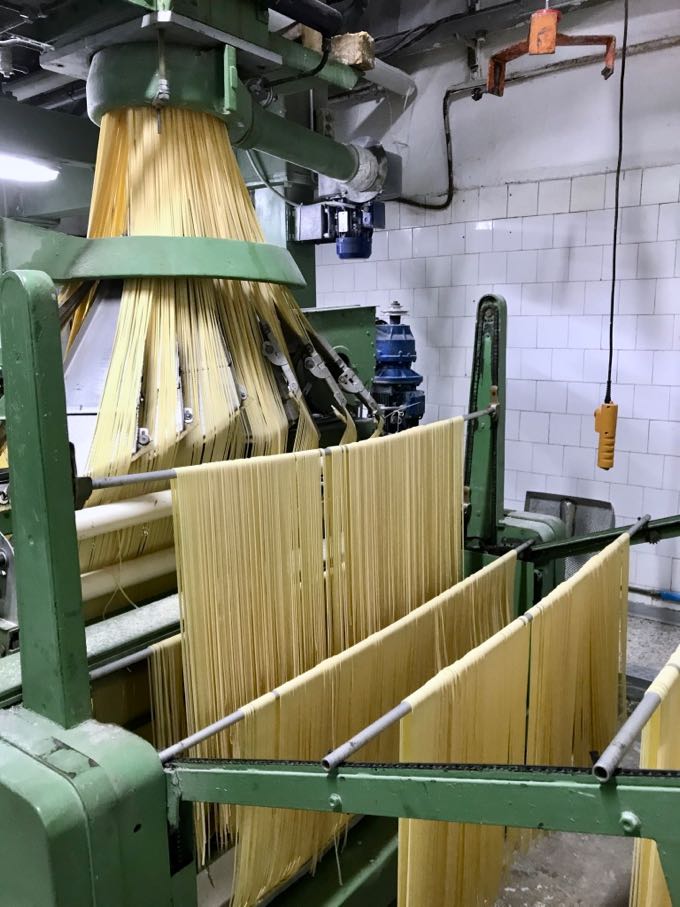
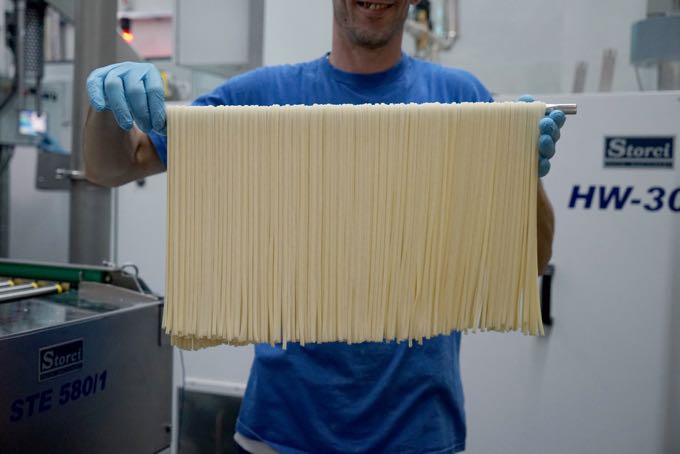
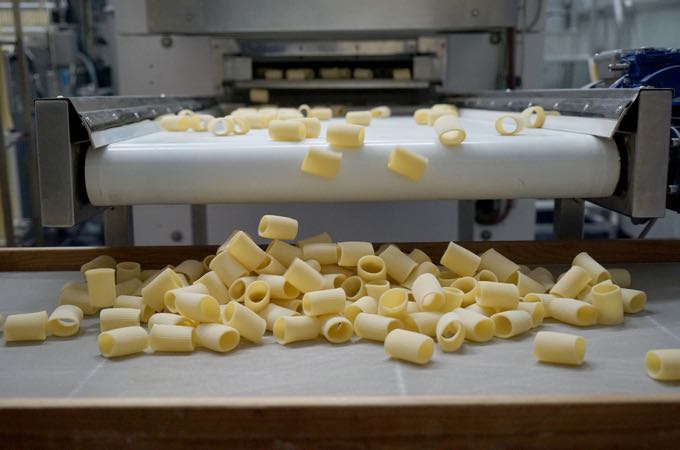
Spaghettone al Pomodoro
Yield 4-5
While I was in Gragnano I had the great luck to not only visit the Pasta Gentile factory but to hang out in the kitchen with Mamma Maria, the matriarch of the Zampino family that owns the company. She prepared various pastas pastas for me to try. Naturally the sauces were simple, to bring out the pure taste of the pasta. My favorite was the Spaghettone she made with a simple tomato sauce. Spaghettone are Gentile's signature pasta, and is a toothsome thick strand of thick spaghetti measuring 2.7 millimeters in diameter . Since there are so few ingredients, the specific choice really does make a huge difference. For this sauce Mamma Maria, like most Italians, use canned pelati San Marzano tomatoes. She actually follows these tomatoes from seed to can, but if you can't manage that see the resources below for the real thing.
Ingredients
- 1 pound/ 1/2 kilo Spaghettoni Gentile
- 70 gr EVO
- 1 smashed garlic clove
- 8 basil leaves
- 750 grams Canned San Marzano Tomatoes
- 1/2 half teaspoon salt
Instructions
Bring a large pot of salted water to boil. Add the pasta. While pasta cooks (if you are using spaghettone then it will take a while) make the sauce.
Pour the olive oil in a saute pan big enough to hold all of the drained, cooked pasta. Add the smashed garlic clove and the basil. After one minute add the canned tomatoes with their juice and salt. Turn heat to high and cooked quickly, using a wooden spoon to break up the tomatoes.
Taste and adjust for seasoning.
Drain the pasta when it is just short of al dente, retaining one cup of cooking water. Put the drained pasta into the pan with the sauce, and stir over medium heat to finish cooking, till al dente. If the sauce seems too dry, add a bit of reserved cooking water.
Serve garnished with fresh basil leaves and grated parmigiano reggiano on the side.
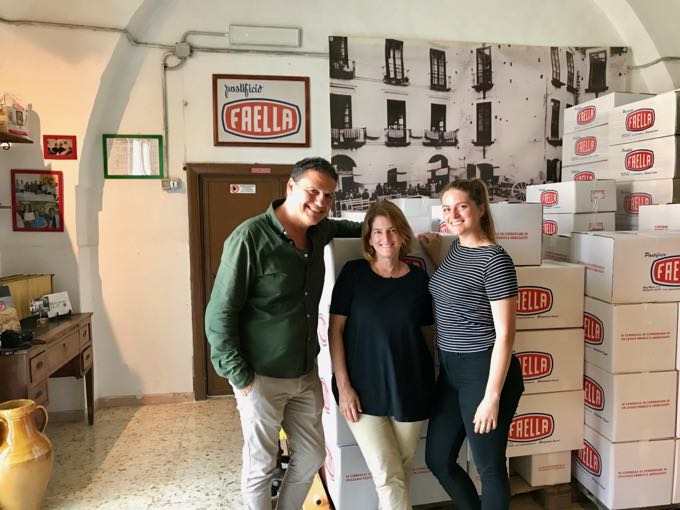
Sophie and I in our happy place: photographed with all the Faella pasta in the world. Along with Sergio Cinque, the owner.
This blog post is an excerpt from my book Eating My Way Through Italy.
More pasta recipes and other information about following your stomach through Italy is in my most recent book Eating My Way Through Italy.
For more on where to eat in Italy, please download my app Eat Italy, available for both iPhoneand Android.
And if you’d like to host your own Italian meal at home, make sure you buy my next book, The Italian Table: Creating Festive Meals for Family and Friends (March 2019), available for preorder.
My husband’s great grandfather is from Gragnano. I plan to take him there next year and I was hoping to arrange a pasta making lesson. I speak Italian, but he does not. Any suggestions? Grazie!!
Send an email to Gentile Pasta, and they may be able to arrange something. They have a lovely place there and you can tour their factory as well.